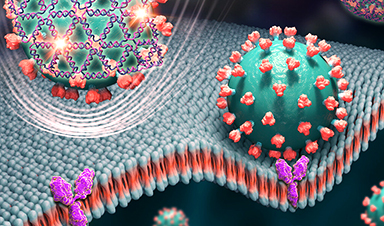Tiny nets woven from DNA strands can ensnare the spike protein of the virus that causes COVID-19, lighting up the virus for a fast-yet-sensitive diagnostic test—and also impeding the virus from infecting cells, opening a new possible route to antiviral treatment, according to a new study.
“This platform combines the sensitivity of PCR and the speed and low cost of antigen tests,” said study leader Xing Wang, a professor of bioengineering and of chemistry at Illinois. “We need tests like this for a couple of reasons. One is to prepare for the next pandemic. The other reason is to track ongoing viral epidemics—not only coronaviruses, but also other deadly and economically impactful viruses like HIV or influenza.”
DNA is best known for its genetic properties, but it also can be folded into custom nanoscale structures that can perform functions or specifically bind to other structures much like proteins do. The DNA nets the Illinois group developed were designed to bind to the coronavirus spike protein—the structure that sticks out from the surface of the virus and binds to receptors on human cells to infect them. Once bound, the nets give off a fluorescent signal that can be read by an inexpensive handheld device in about 10 minutes.
The researchers demonstrated that their DNA nets effectively targeted the spike protein and were able to detect the virus at very low levels, equivalent to the sensitivity of gold-standard PCR tests that can take a day or more to return results from a clinical lab.
The technique holds several advantages, Wang said. It does not need any special preparation or equipment, and can be performed at room temperature, so all a user would do is mix the sample with the solution and read it. The researchers estimated in their study that the method would cost $1.26 per test.
“Another advantage of this measure is that we can detect the entire virus, which is still infectious, and distinguish it from fragments that may not be infectious anymore,” Wang said. This not only gives patients and physicians better understanding of whether they are infectious, but it could greatly improve community-level modeling and tracking of active outbreaks, such as through wastewater.
In addition, the DNA nets inhibited the virus’s spread in live cell cultures, with the antiviral activity increasing with the size of the DNA net scaffold. This points to DNA structures’ potential as therapeutic agents, Wang said.
“I had this idea at the very beginning of the pandemic to build a platform for testing, but also for inhibition at the same time,” Wang said. “Lots of other groups working on inhibitors are trying to wrap up the entire virus, or the parts of the virus that provide access to antibodies. This is not good, because you want the body to form antibodies. With the hollow DNA net structures, antibodies can still access the virus.”
The DNA net platform can be adapted to other viruses, Wang said, and even multiplexed so that a single test could detect multiple viruses.
“We’re trying to develop a unified technology that can be used as a plug-and-play platform. We want to take advantage of DNA sensors’ high binding affinity, low limit of detection, low cost and rapid preparation,” Wang said.
The paper is titled “Net-shaped DNA nanostructures designed for rapid/sensitive detection and potential inhibition of the SARS-CoV-2 virus.”
News
New skin-permeable polymer delivers insulin without needles
A breakthrough zwitterionic polymer slips through the skin’s toughest barriers, carrying insulin deep into tissue and normalizing blood sugar, offering patients a painless alternative to daily injections. A recent study published in the journal Nature examines [...]
Multifunctional Nanogels: A Breakthrough in Antibacterial Strategies
Antibiotic resistance is a growing concern - from human health to crop survival. A new study successfully uses nanogels to target and almost entirely inhibit the bacteria P. Aeruginosa. Recently published in Angewandte Chemie, the study [...]
Nanoflowers rejuvenate old and damaged human cells by replacing their mitochondria
Biomedical researchers at Texas A&M University may have discovered a way to stop or even reverse the decline of cellular energy production—a finding that could have revolutionary effects across medicine. Dr. Akhilesh K. Gaharwar [...]
The Stunning New Push to Protect the Invisible 99% of Life
Scientists worldwide have joined forces to build the first-ever roadmap for conserving Earth’s vast invisible majority—microbes. Their new IUCN Specialist Group reframes conservation by elevating microbial life to the same urgency as plants and [...]
Scientists Find a Way to Help the Brain Clear Alzheimer’s Plaques Naturally
Scientists have discovered that the brain may have a built-in way to fight Alzheimer’s. By activating a protein called Sox9, researchers were able to switch on star-shaped brain cells known as astrocytes and turn them into [...]
Vision can be rebooted in adults with amblyopia, study suggests
Temporarily anesthetizing the retina briefly reverts the activity of the visual system to that observed in early development and enables growth of responses to the amblyopic eye, new research shows. In the common vision [...]
Ultrasound-activated Nanoparticles Kill Liver Cancer and Activate Immune System
A new ultrasound-guided nanotherapy wipes out liver tumors while training the immune system to keep them from coming back. The study, published in Nano Today, introduces a biodegradable nanoparticle system that combines sonodynamic therapy and cell [...]
Magnetic nanoparticles that successfully navigate complex blood vessels may be ready for clinical trials
Every year, 12 million people worldwide suffer a stroke; many die or are permanently impaired. Currently, drugs are administered to dissolve the thrombus that blocks the blood vessel. These drugs spread throughout the entire [...]
Reviving Exhausted T Cells Sparks Powerful Cancer Tumor Elimination
Scientists have discovered how tumors secretly drain the energy from T cells—the immune system’s main cancer fighters—and how blocking that process can bring them back to life. The team found that cancer cells use [...]
Very low LDL-cholesterol correlates to fewer heart problems after stroke
Brigham and Women's Hospital's TIMI Study Group reports that in patients with prior ischemic stroke, very low achieved LDL-cholesterol correlated with fewer major adverse cardiovascular events and fewer recurrent strokes, without an apparent increase [...]
“Great Unified Microscope” Reveals Hidden Micro and Nano Worlds Inside Living Cells
University of Tokyo researchers have created a powerful new microscope that captures both forward- and back-scattered light at once, letting scientists see everything from large cell structures to tiny nanoscale particles in a single shot. Researchers [...]
Breakthrough Alzheimer’s Drug Has a Hidden Problem
Researchers in Japan found that although the Alzheimer’s drug lecanemab successfully removes amyloid plaques from the brain, it does not restore the brain’s waste-clearing system within the first few months of treatment. The study suggests that [...]
Concerning New Research Reveals Colon Cancer Is Skyrocketing in Adults Under 50
Colorectal cancer is striking younger adults at alarming rates, driven by lifestyle and genetic factors. Colorectal cancer (CRC) develops when abnormal cells grow uncontrollably in the colon or rectum, forming tumors that can eventually [...]
Scientists Discover a Natural, Non-Addictive Way To Block Pain That Could Replace Opioids
Scientists have discovered that the body can naturally dull pain through its own localized “benzodiazepine-like” peptides. A groundbreaking study led by a University of Leeds scientist has unveiled new insights into how the body manages pain, [...]
GLP-1 Drugs Like Ozempic Work, but New Research Reveals a Major Catch
Three new Cochrane reviews find evidence that GLP-1 drugs lead to clinically meaningful weight loss, though industry-funded studies raise concerns. Three new reviews from Cochrane have found that GLP-1 medications can lead to significant [...]
How a Palm-Sized Laser Could Change Medicine and Manufacturing
Researchers have developed an innovative and versatile system designed for a new generation of short-pulse lasers. Lasers that produce extremely short bursts of light are known for their remarkable precision, making them indispensable tools [...]





















